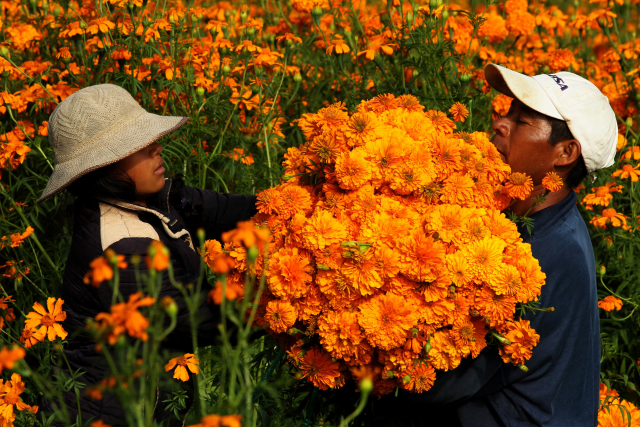
A sea of bright orange flowers sways in the wind, releasing the intense fragrance of the blossoms across the foothills of Mexico’s Popocatepetl volcano.
Infused with pre-Hispanic mysticism, the petals of the cempasuchil flower, or the Mexican marigold, form the orange-carpeted path that guides souls on the Day of the Dead.
The distinctive flower is an essential part of the offerings Mexicans prepare for the climax of the traditional celebration held to honor the departed, which ends on Friday.
“An altar without cempasuchil flowers isn’t an offering,” says Yessica Ponte, a 28-year-old who, machete in hand, harvests the flower in Nealtican, in central Mexico.
According to Aztec legend, the cempasuchil was created from the body of a woman, Xochitl, pining for death so she could rejoin her deceased warrior lover, Huitzilin.
The pair had vowed to love each other even beyond death on the mountain dedicated to the sun god Tonatiuh.
But when Huitzilin was killed in battle, a devastated Xochitl begged the gods to take her to the world of the dead.
Tonatiuh dropped his rays onto Xochitl, transforming her into a flower that resembled the sunlight.
Huitzilin, reincarnated as a hummingbird, landed on the flower, opening its petals and releasing its fragrance.
Tradition has it that the couple’s love will last as long as there are hummingbirds and cempasuchil flowers in the fields.
Bread of the dead
Some 1,700 hectares (4,200 acres) across 14 states — from Baja California in the north to Oaxaca in the south — are dedicated to growing the iconic flower.
But the majority of the orange fields are found in Puebla state which, according to official figures from 2017, produces 11,500 of the 15,000 tons of the country’s total cempasuchil production.
On the Day of the Dead, big bouquets of flowers are arranged around portraits of deceased loved ones alongside white candles, mini-skulls made of sugar and chocolate, as well as the sweet and spongy ‘bread of the dead” and other delicacies the dearly departed enjoyed in life.
“I put as many flowers as I can, with a trail (of petals) that goes to the street” to help the spirits of her grandparents find their way back to the house, a smiling Ponte told AFP.
According to some beliefs, the marigold’s petals, which range in color from a penetrating yellow to intense pink, soak up the sun’s heat and represent the divine.
The flower’s name comes from the word “Cempohualxochitl” in the Nahuatl language — “20 flowers,” from cempohuali (20) and xochitl, which is the word for flower as well as the name of the folk heroine.
The flower had a multitude of uses in pre-Columbian Mexico — decorating altars and graves, painting the faces of prisoners marked for sacrifice, and as an ingredient in some remedies for diseases.
“It’s important to preserve traditions because they generate a lot for the economy,” said Ponte, who worked 12-hour days during the late October harvest.
She was paid 10 pesos ($0.50) for every bunch of 50 flowers.
‘We can’t cope’
“In this season we cannot cope with the sales — everyone walks away with cempasuchil,” says Raimundo Ramos, a flower-seller at a market in Mexico City, where a small bunch of 10 flowers costs 40 pesos.
Last year’s harvest generated a production value of 55 million pesos — about $2.7 million.
As well as a traditional offering at this time of year, Mexican marigolds are used in insecticides and as a colorant in chicken feed, to give eggs a yellow glow.
It’s also used in creamy soups and as a tonic for digestive, respiratory and fever problems.
“Pharmaceutical studies demonstrate that it has bacteria-fighting properties,” said biologist Lizandra Salazar.
For 78-year-old healer Carmen Felix, modern scientific findings about the flower’s healing properties confirm rather than disprove the legends surrounding the cempasuchil.
“Xochitl’s eternal love, embodied in this flower, cures us of our ailments,” she says, plucking petals in her lap.
“All illnesses come from sadness or fear, and only love can cure these things.” AB
RELATED STORIES:
Shibuya Halloween street partygoers damage parked truck
WATCH: DJ Hello Kitty brings house down at Sanrio Halloween event
Japanese park attendant too shy to talk to foreign tourists let them in for free for 2 years










































